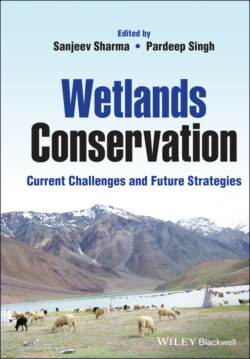Читать книгу Wetlands Conservation - Группа авторов - Страница 23
2.1 Background
ОглавлениеWetlands are among the most biodiverse ecosystems on the Earth. They occur where the water table is at or near the surface of the land or where the land is covered by shallow water (Ramsar Convention Secretariat 2011). In wetlands, water is the primary factor that controls the associated biotic and abiotic environment. Wetlands offer multiple benefits, including ecological as well as socioeconomic, to humans and other biota. They provide habitats to as many as 20% of the planet’s various life‐forms (Gopal 1977). The major civilizations have emerged and flourished along the fertile floodplains of some of the largest river systems of the world like Indus, Nile, Euphrates, and Tigris, and often wetlands are called “the cradle of human civilization” (Grist 1975). The wide range of ecosystem services that the diverse types of wetlands provide have been classified into four types, i.e. provisioning, regulating, cultural, and supporting services (Millennium Ecosystem Assessment 2005). The wetlands are often referred to as “biological supermarkets,” owing to their high primary productivity, rich biodiversity and hosting of intricately woven food webs (Gawler 2000; Prasad et al. 2002). Despite the multiple intangible benefits they offer, the true worth of the wetland services has never really been accounted for. The overexploitation, degradation, and conversion of wetlands around the world have probably been going on ever since humans have found access to them. Unfortunately, of all‐natural ecosystems, wetland ecosystems have suffered the most (Davidson et al. 2005). Studies have revealed that the wetlands around the world had degraded by about 87% since 1700 in data‐existing regions, with a majority of this degradation occurring in the twentieth and early twenty‐first centuries (Gawler 2000). In Europe, their thoughtless conversion has been going on since the times of the Romans (Davidson et al. 1991); in North America and southern Africa since the seventeenth century (Dahl 1990; Kotze et al. 1995); and in China, for at least last 2000 years (An et al. 2007). It has been estimated that at least 50% of valuable wetland ecosystems have been lost since 1900 (Dugan 1993; OECD 1996; Mitsch and Gosselink 2015; and Ramsar Convention Bureau 2015). In fact, around 35% of the wetland area has been lost between 1970 and 2015 (Gardner and Finlayson 2018). In terms of economic value, Costanza et al. (2014) estimated an annual loss of 9.9 trillion dollars in the value of marsh wetland ecosystem services over a period of 14 years from 1997 to 2011 (Costanza et al. 2014).
Though the wetland conversion and their corresponding decline have been going on for centuries, it was only in the early part of the twentieth century that their significance was realized and, consequently, deliberations toward their conservation began to gain strength. In North America, many researchers started raising their concerns on waterfowl decline as a result of wetland drainage since the 1920s (Schmidt 2006). In Europe, the conservationists had been projecting the issues of wetland degradation from the early 1960s (Hoffmann 1964; Swift 1964). This prompted the IUCN to launch the MAR Project (from “MARshes,” “MARécages,” and “MARismas”) for the conservation and management of wetlands in the early 1960s. The project MAR was conceived during the MAR conference held in French Camargue from 12 to 16 November 1962 (Hoffmann 1964; Ramsar Convention Secretariat 2011). The recommendations made during the MAR conference later paved the way for the establishment of an international convention on wetlands at the Ramsar Convention in 1971 (Matthews 1993; Ramsar Convention Secretariat 2011; Davidson 2014).
